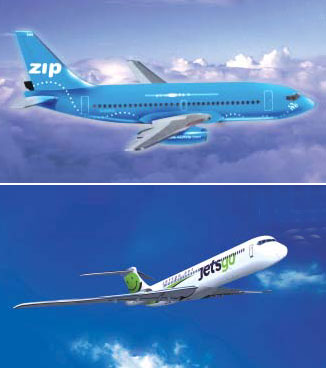
Features
Airlines
Air Wal-Mart? A Look at Canadian Low-Cost Carriers
Listening
to Stephen Smith, one would have thought
that he was launching a new discount retail chain rather than an
airline.
October 3, 2007 By Sam Barone
 Listening to Stephen Smith, president of Zip, at the press
Listening to Stephen Smith, president of Zip, at the press
conference launching Air Canada's new low-cost brand on April 19, one
would have thought that he was launching a new discount retail chain
rather than an airline. Smith, who was earlier president of WestJet
Airlines, stated that "there is a low-cost, or Wal-Mart shift going on
in the airline market."
Continuing the retail analogy, Smith added: "Air Canada cannot and
will not be another Eaton's." Interestingly,WestJet had also referred
to Wal-Mart in its original business plan back in 1996, as did
Southwest Airlines of Dallas, as a consumer trend that could not be
ignored.
The Low-Cost Carrier (LCC) business model is simple. Its key
attributes include minimal in-flight service, low costs, price
leadership, frequent point-to-point service, and market stimulation.
Southwest Airlines is the most successful LCC in airline history. In
1996, Calgary-based WestJet brought the LCC concept to Canada and has
followed the Southwest management philosophy and profits all the way to
the bank. Little did WestJet's founders realize that their airline
would grow from a regional start-up to become the standard for LCCs in
Canada. Since 1996 the company has grown from three aircraft serving
seven destinations with revenue of $37 million to almost $479 million
in revenue (2001) and net earnings of $37.2 million, with service to 22
destinations with 28 Boeing 737s, six of which are next-generation 700
series.